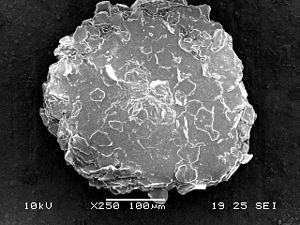Scurf
| Dandruff | |
|---|---|
 |
|
| A microscopic image of human dandruff | |
| Classification and external resources | |
| Specialty | Dermatology |
| ICD-9-CM | 690.18 |
| DiseasesDB | 11911 |
| MeSH | D063807 |
Dandruff is the shedding of dead skin cells from the scalp. As skin cells die, a small amount of flaking is normal; about 487,000 cells/cm2 are released normally after detergent treatment. Some people, however, experience an unusually large amount of flaking either chronically or as a result of certain triggers, up to 800,000 cells/cm2, which can also be accompanied by redness and irritation.
Dandruff is a common scalp disorder affecting almost half of the population at the post-pubertal age and of any sex and race. It often causes itching. It has been established that keratinocytes play a key role in the expression and generation of immunological reactions during dandruff formation. The severity of dandruff may fluctuate with season as it often worsens in winter. Dandruff is rare before puberty, peaks in the teens and early twenties, and declines with age thereafter. Most cases of dandruff can be treated with specialized shampoos. There is, however, no known cure.
Those affected by dandruff find that it can cause social or self-esteem problems, indicating treatment for both psychological and physiological reasons.
The signs and symptoms of dandruff are an itchy scalp and flakiness. Red and greasy patches of skin and a tingly feeling on the skin are also symptoms.
Dandruff can have several causes, including dry skin, seborrhoeic dermatitis, not cleaning/scrubbing often enough, shampooing too often, psoriasis, eczema, sensitivity to hair care products, or a yeast-like fungus. Dry skin is the most common cause of flaking dandruff.
As the epidermal layer continually replaces itself, cells are pushed outward where they eventually die and flake off. For most individuals, these flakes of skin are too small to be visible. However, certain conditions cause cell turnover to be unusually rapid, especially in the scalp. It is hypothesized that for people with dandruff, skin cells may mature and be shed in 2–7 days, as opposed to around a month in people without dandruff. The result is that dead skin cells are shed in large, oily clumps, which appear as white or grayish flakes on the scalp, skin and clothes.
...
Wikipedia
